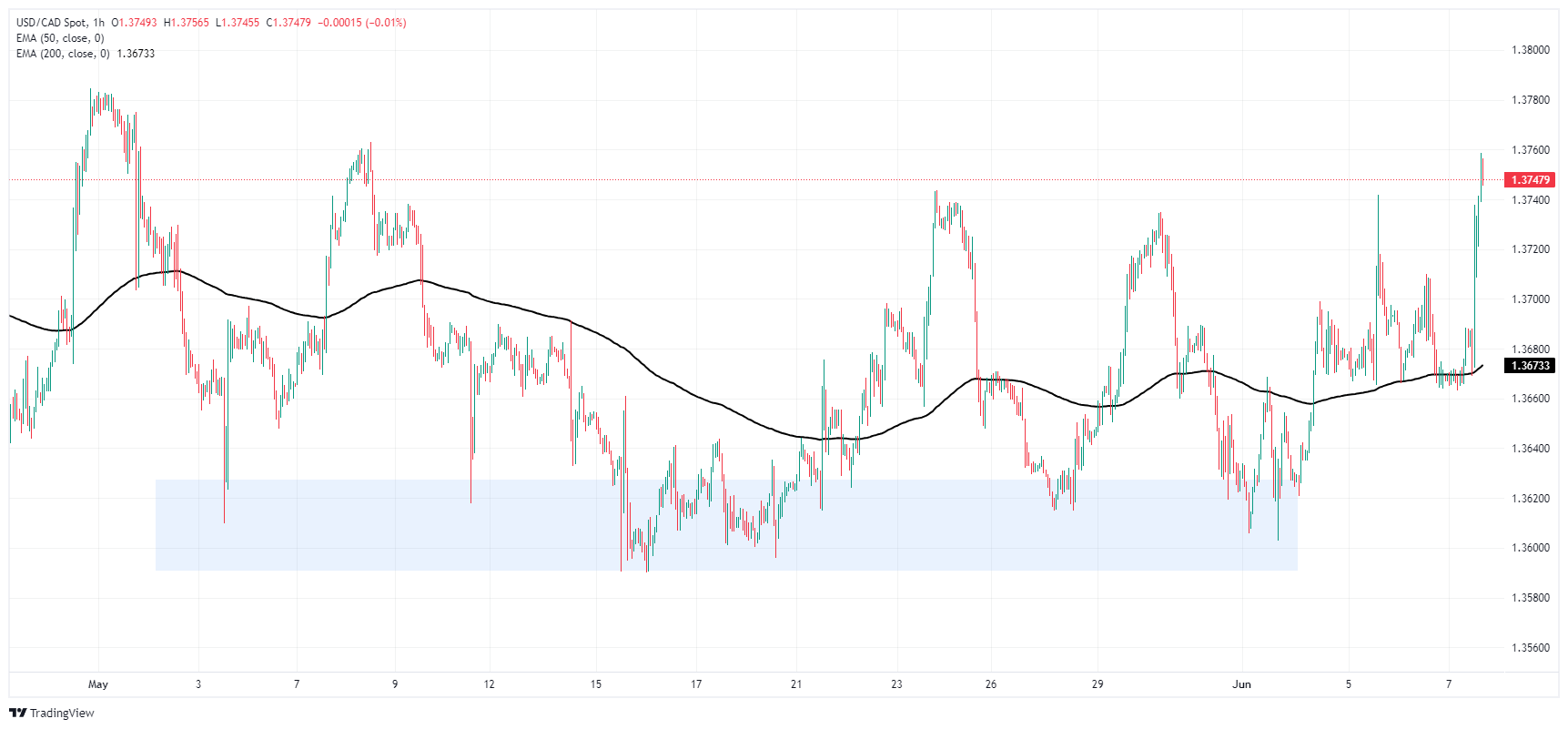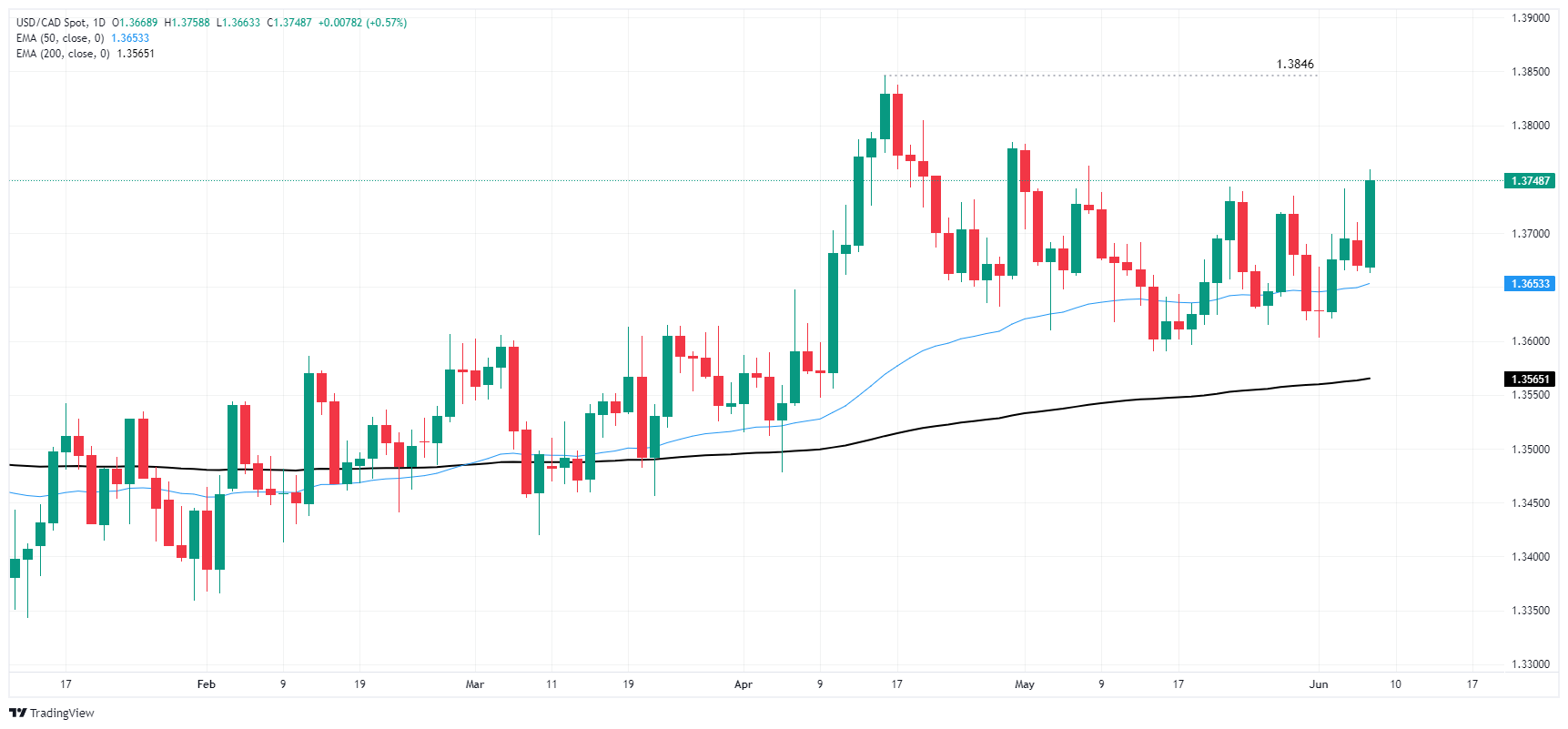- Phân tích
- Tin tức và các công cụ
- Tin tức thị trường
- Canadian Dollar has a hot Friday, but Greenback comes in hotter after NFP scorcher
Canadian Dollar has a hot Friday, but Greenback comes in hotter after NFP scorcher
- Canadian Dollar tumbles -0.6% against US Dollar on Friday.
- Canada added more jobs than expected but is eclipsed by US NFP.
- Bumper job additions and rising wages crimp rate cut hopes.
The Canadian Dollar (CAD) is giving a mixed performance on Friday, climbing against the majority of its major currency peers but backsliding against the US Dollar (USD). The CAD shed six-tenths of a percent against the Greenback after a bumper US Nonfarm Payrolls (NFP) sent the USD broadly higher as investor hopes for a September rate cut from the Federal Reserve (Fed) wither on the vine.
Canada added more jobs than expected in May, but the figure was still well below previous figures, limiting the CAD’s upside momentum. Hourly wages also gained ground in both Canada and the US, while the US Unemployment Rate ticked higher in a cautionary note to Friday’s otherwise clean beat of market forecasts.
Daily digest market movers: Fresh job additions crimp rate cut bets
- US NFP added 272K net new jobs in May, clobbering the 185K forecast though the previous month’s print was revised lower to 165K from 175K.
- The US Unemployment Rate ticked higher to 4.0% in May, a 28-month high.
- US Average Hourly Earnings rose 0.4% MoM in May, above the forecast 0.3% and doubling the previous 0.2%.
- Canada’s Net Change in Employment rose to 26.7K in May, above the 22.5K forecast but still well below the previous month’s 90.4K.
- According to the CME’s FedWatch Tool, investor hopes for a September rate cut from the Fed were knocked firmly back by US data on Friday. Rate traders are pricing in only a 55% chance of at least a quarter-point cut from the Fed on September 8, down from over 70% before the US NFP print.
Canadian Dollar PRICE Today
The table below shows the percentage change of Canadian Dollar (CAD) against listed major currencies today. Canadian Dollar was the weakest against the US Dollar.
| USD | EUR | GBP | JPY | CAD | AUD | NZD | CHF | |
|---|---|---|---|---|---|---|---|---|
| USD | 0.76% | 0.50% | 0.66% | 0.59% | 1.18% | 1.39% | 0.79% | |
| EUR | -0.76% | -0.24% | -0.14% | -0.17% | 0.42% | 0.69% | 0.01% | |
| GBP | -0.50% | 0.24% | 0.12% | 0.07% | 0.67% | 0.93% | 0.25% | |
| JPY | -0.66% | 0.14% | -0.12% | -0.05% | 0.53% | 0.76% | 0.14% | |
| CAD | -0.59% | 0.17% | -0.07% | 0.05% | 0.59% | 0.87% | 0.18% | |
| AUD | -1.18% | -0.42% | -0.67% | -0.53% | -0.59% | 0.26% | -0.42% | |
| NZD | -1.39% | -0.69% | -0.93% | -0.76% | -0.87% | -0.26% | -0.66% | |
| CHF | -0.79% | -0.01% | -0.25% | -0.14% | -0.18% | 0.42% | 0.66% |
The heat map shows percentage changes of major currencies against each other. The base currency is picked from the left column, while the quote currency is picked from the top row. For example, if you pick the Canadian Dollar from the left column and move along the horizontal line to the US Dollar, the percentage change displayed in the box will represent CAD (base)/USD (quote).
Technical analysis: Canadian Dollar grinds out some gains as US Dollar soars
The Canadian Dollar (CAD) tumbled six-tenths of one percent against the Greenback on Friday, but otherwise stuck to its guns. The CAD rose three-quarters of one percent against the New Zealand Dollar (NZD) and six-tenths of one percent against the Australian Dollar (AUD). The CAD is also in the green within a fifth of a percent against the Euro (EUR) and the Swiss Franc (CHF).
USD/CAD shot to fresh near-term highs above 1.3750 on Friday, bumping into the ceiling of recent consolidation patterns. The pair is set to continue grinding sideways in the medium-term as buying power in the US Dollar evaporates at familiar technical highs.
Daily candlesticks show the pair on pace to see its strongest close in over a month, and bumping into its highest bids since early May. Consolidation remains the name of the game in the long-term, though USD/CAD continues to grind out chart paper north of the 200-day Exponential Moving Average (EMA).
USD/CAD hourly chart
USD/CAD daily chart
Canadian Dollar FAQs
The key factors driving the Canadian Dollar (CAD) are the level of interest rates set by the Bank of Canada (BoC), the price of Oil, Canada’s largest export, the health of its economy, inflation and the Trade Balance, which is the difference between the value of Canada’s exports versus its imports. Other factors include market sentiment – whether investors are taking on more risky assets (risk-on) or seeking safe-havens (risk-off) – with risk-on being CAD-positive. As its largest trading partner, the health of the US economy is also a key factor influencing the Canadian Dollar.
The Bank of Canada (BoC) has a significant influence on the Canadian Dollar by setting the level of interest rates that banks can lend to one another. This influences the level of interest rates for everyone. The main goal of the BoC is to maintain inflation at 1-3% by adjusting interest rates up or down. Relatively higher interest rates tend to be positive for the CAD. The Bank of Canada can also use quantitative easing and tightening to influence credit conditions, with the former CAD-negative and the latter CAD-positive.
The price of Oil is a key factor impacting the value of the Canadian Dollar. Petroleum is Canada’s biggest export, so Oil price tends to have an immediate impact on the CAD value. Generally, if Oil price rises CAD also goes up, as aggregate demand for the currency increases. The opposite is the case if the price of Oil falls. Higher Oil prices also tend to result in a greater likelihood of a positive Trade Balance, which is also supportive of the CAD.
While inflation had always traditionally been thought of as a negative factor for a currency since it lowers the value of money, the opposite has actually been the case in modern times with the relaxation of cross-border capital controls. Higher inflation tends to lead central banks to put up interest rates which attracts more capital inflows from global investors seeking a lucrative place to keep their money. This increases demand for the local currency, which in Canada’s case is the Canadian Dollar.
Macroeconomic data releases gauge the health of the economy and can have an impact on the Canadian Dollar. Indicators such as GDP, Manufacturing and Services PMIs, employment, and consumer sentiment surveys can all influence the direction of the CAD. A strong economy is good for the Canadian Dollar. Not only does it attract more foreign investment but it may encourage the Bank of Canada to put up interest rates, leading to a stronger currency. If economic data is weak, however, the CAD is likely to fall.
© 2000-2024. Bản quyền Teletrade.
Trang web này được quản lý bởi Teletrade D.J. LLC 2351 LLC 2022 (Euro House, Richmond Hill Road, Kingstown, VC0100, St. Vincent and the Grenadines).
Thông tin trên trang web không phải là cơ sở để đưa ra quyết định đầu tư và chỉ được cung cấp cho mục đích làm quen.
Giao dịch trên thị trường tài chính (đặc biệt là giao dịch sử dụng các công cụ biên) mở ra những cơ hội lớn và tạo điều kiện cho các nhà đầu tư sẵn sàng mạo hiểm để thu lợi nhuận, tuy nhiên nó mang trong mình nguy cơ rủi ro khá cao. Chính vì vậy trước khi tiến hành giao dịch cần phải xem xét mọi mặt vấn đề chấp nhận tiến hành giao dịch cụ thể xét theo quan điểm của nguồn lực tài chính sẵn có và mức độ am hiểu thị trường tài chính.
Sử dụng thông tin: sử dụng toàn bộ hay riêng biệt các dữ liệu trên trang web của công ty TeleTrade như một nguồn cung cấp thông tin nhất định. Việc sử dụng tư liệu từ trang web cần kèm theo liên kết đến trang teletrade.vn. Việc tự động thu thập số liệu cũng như thông tin từ trang web TeleTrade đều không được phép.
Xin vui lòng liên hệ với pr@teletrade.global nếu có câu hỏi.















